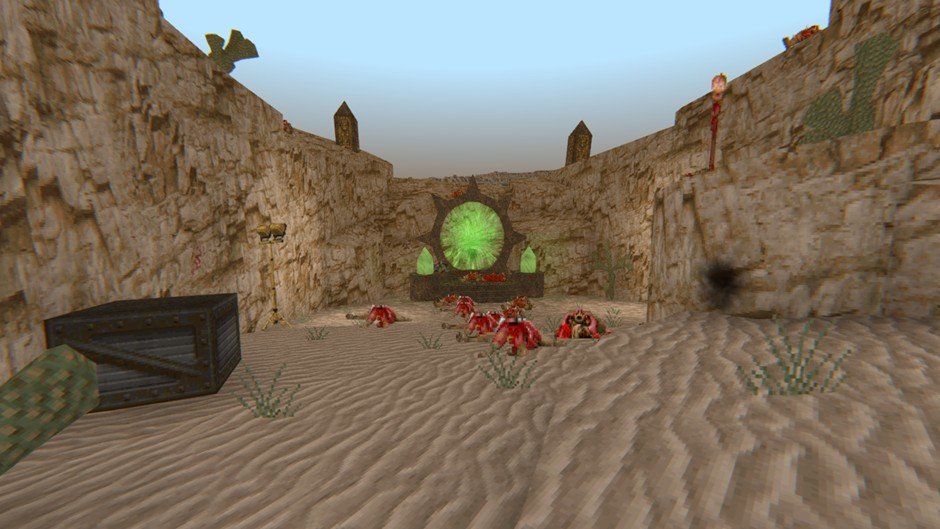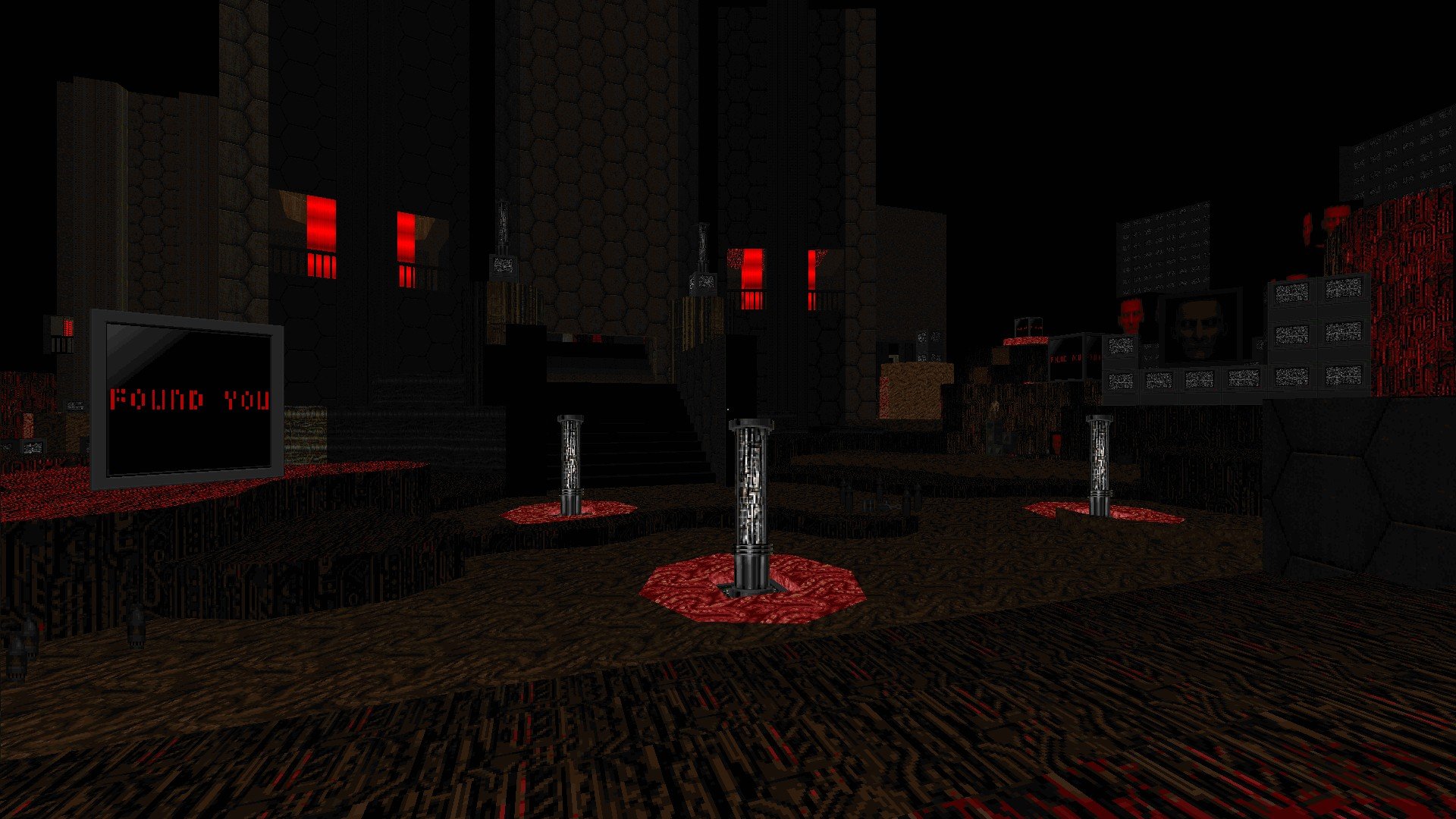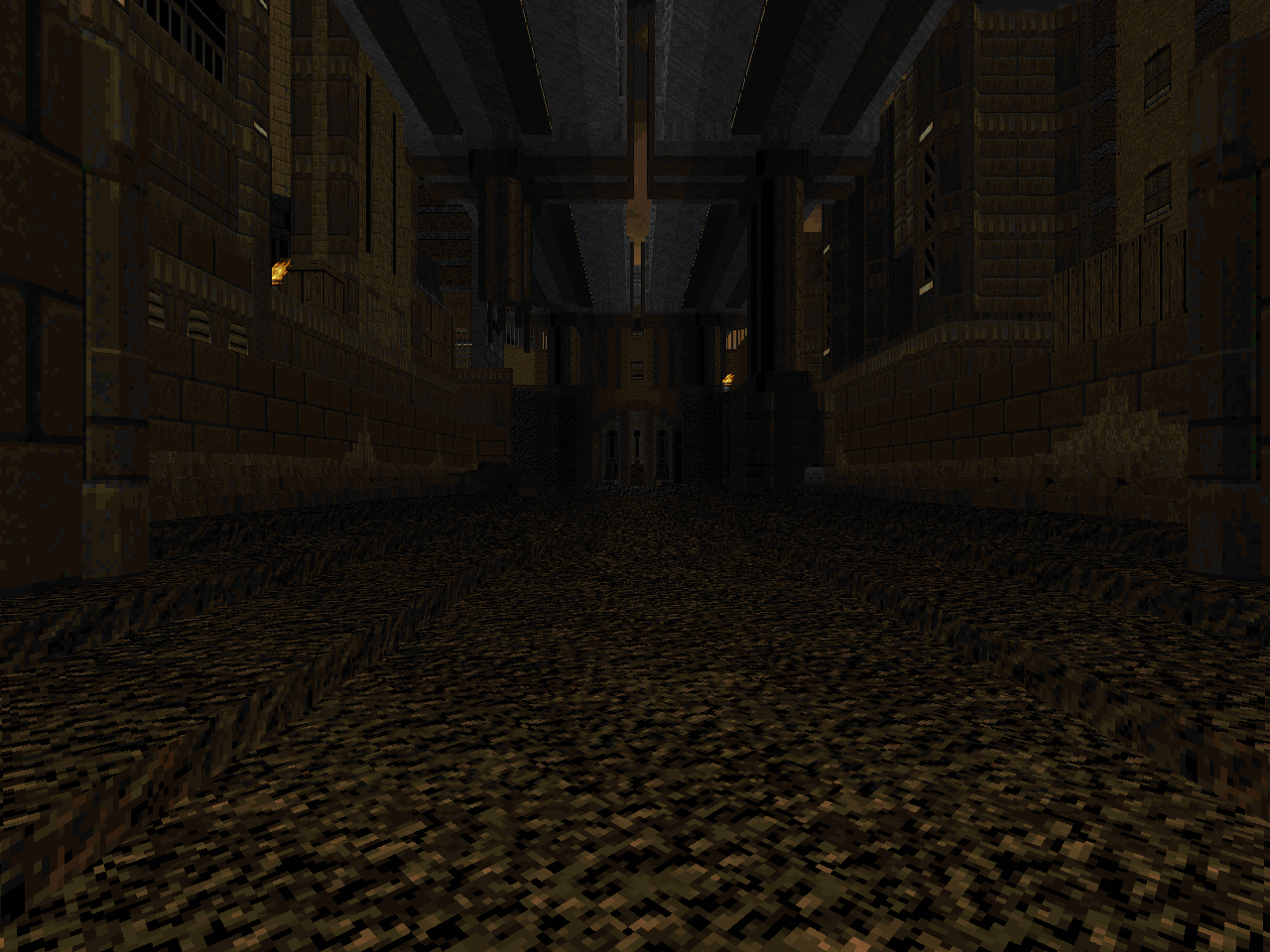-
 Elementalism: Phase 1 - @Bauul et al.
Elementalism: Phase 1 - @Bauul et al.
Doom 2, GZDoom, 16 maps
One of the most anticipated projects of the year, Elementalism immediately arouses curiosity regarding its intensive usage of source port features, however, it also makes one thing clear from the get go: no compromises were made in making sure one of the most beautiful and impressive releases ever made for this game feels and plays Doom all the way. Backed by an all-star cast featuring some of the community's most accomplished mappers, Bauul spearheaded a nearly overachieving project, chock full of grandiose detail and nearly unparalleled in scope.
Legend says that eons ago, six powerful deities of the elements sought to seal the power of the seventh and most powerful one, Entropy, the end of all things. Now, as their powers wain, Entropy plans its grand return, unleashing the numberless legions of Hell upon the six realms in a bid for total domination. Only a lone space marine stands in the way, ready and willing to plunge deep into the elemental realms to put an end to this apocalyptic threat. In reality, we are talking about three realms for now, as Elementalism was understandably split into two parts owing to its immense size and scope. Not that this stops the current package that we got from feeling any less complete. The three portals will take you on an epic journey through the realms of Earth, Water and Fire. These may be tackled in any order, and it is possible to return to the hub map at any point if you want - as a matter of fact, there's quite a few options involved, including the built in ability to begin each new level with pistol start.
But let's look at the realms themselves more closely. In the Earth realm you will initially trek through the dense jungles, ancient shrines and mossy caves of a lush world that progressively gives way to scorched, barren yet striking landscapes, as if the Demons and their Parasite are sucking away the very life from the soil. The Water world remains dazzling and colorful throughout, be it thanks to the rocky landscape surrounded by water or the marvelous temples of a bygone civilization, evidently overtaken by the infernal hordes and their waterborne master. Finally, the magma-flooded depths of the Fire world might initially seem a more conventional setting, but the towering volcanoes, steampunk machinery and flame jets pouring from every which grate make this anything but your average Hell setting in spite of its familiar defenders and its not-so-familiar overlord. Even beyond the visual themes of each episode, there is no shortage of jaw-dropping, completely unexpected moments. What might seem like your standard spelunking through an underground temple gives way to a large central room containing a huge, rotating 3D staircase that completely changes the way you approach the level itself. Another deep descent into the underground reveals a massive structure cubical seemingly built out gears, and just as the realization of what you're seeing comes in, suddenly you find yourself inside the structure, which rotates on itself, constantly altering the level's layout. Not that things are any more constrained outdoors, with the fallen city of Hedania alone instantly captivating players with its soaring architecture, bewitchingly constructed into a massive natural canyon: a vertigo-inducing landscape that's both alluring and demoralizing for any mortal soul.
All of these surprises are exceptional because they come off as extremely novel but also feel deeply ingrained and integral to the worlds themselves. All of the three realms have a unique quality of making the player feel at ease thanks to the often lush and colorful environments, and yet the same exact maps give off a sense of uneasiness, like you are a stranger in a strange land, interferring in cosmic designs you cannot even begin to understand. Your interference is understood well by your enemies, as foes old and new alike are waiting to meet you in combat: while the vanilla bestiary remains intact, there are several new additions that are exclusive to each elemental world. Your UAC ordnance is complemented by the mysterious Elemental Wand that not only unlocks the portals but also serves as a unique weapon that behaves differently depending on which realm you are on. To top it all off, there are the new, incredibly elaborate and quite difficult boss battles, easily some of the most impressive seen in this game up to this point.
Of course, an excellent production such as this requires equally magnificent music to go with it, and the bespoke, high quality soundtrack matches every location perfectly, further enhancing the otherworldly ambience and sheer calamity you are facing. As striking as your journey is, Entropy yet plots and schemes, and the fate of the universe rests on the next set of elemental realms, yet to be unleashed by Bauul and the rest of the team. For that, we can only say that it cannot happen soon enough. -
 Capybara - @Nefelibeta et al.
Capybara - @Nefelibeta et al.
Doom 2, Boom-compatible, 22 maps
The Doom marine seems to owe a certain obligation to the animal kingdom, perhaps as a penance for failing to protect Daisy all those years ago. If the "frog and toad" series and axolotl.wad are any indication, the path to earning their respect can be arduous yet rewarding for those who rise to the task. It is that spirit in which players who've earned the titles of honorary frog and salamander can now answer the call of the capybara clan in this new 22-map community project, led by the relatively new but talented mapper Nefelibeta.
 Dancing to the tune of its inspirations, Capybara tests your mettle in a taxing gauntlet of colorful voidscapes. This team of authors channeled their inner Ribbiks to deliver punishing combat and platforming but with an irreverently quirky slant. Dodging demon fire while leaping between flower-shaped platforms, mowing down monsters by the hundreds on a giant checkerboard, or ducking from the (literal) piercing glare of Magnolia-like evil eyes are just par for the course. Within this festively-decorated realm, your battleground can resemble more of a playground, but it remains a crucible for all but the most experienced players. Your only solace lies with the titular rodents who appear in secret (sometimes unmarked or unreachable) places within each map, even occasionally offering items to aid your mission. Beguiling though they may be, you wouldn't ignore their plight, would you?
Dancing to the tune of its inspirations, Capybara tests your mettle in a taxing gauntlet of colorful voidscapes. This team of authors channeled their inner Ribbiks to deliver punishing combat and platforming but with an irreverently quirky slant. Dodging demon fire while leaping between flower-shaped platforms, mowing down monsters by the hundreds on a giant checkerboard, or ducking from the (literal) piercing glare of Magnolia-like evil eyes are just par for the course. Within this festively-decorated realm, your battleground can resemble more of a playground, but it remains a crucible for all but the most experienced players. Your only solace lies with the titular rodents who appear in secret (sometimes unmarked or unreachable) places within each map, even occasionally offering items to aid your mission. Beguiling though they may be, you wouldn't ignore their plight, would you?
Hyperbole and fabricated capybara-canon aside, this group does a remarkable job celebrating the spirit of the project's progenitors, providing exciting and memorable challenges while also injecting their own personal touches to create something fresh. An existing mold is utilized, but the result has established an identity of its own and makes for a worthy successor... and what started as a "speedmap" collaboration became all the more impressive for exceeding expectations. Perhaps in the wake of this project, sometime in the future, a new species will find their savior?- @Vile
-
Doom 2, GZDoom, 2 maps
We begin our journey with a memo from your colleagues over at UAC – there is a hidden artifact blade that was found in the ruins of an ancient civilization beneath an arid world plagued by dust storms. Your mission is to retrieve the blade from the hands of the demons who invaded the land, seeking to regain their lost artifact. Y'know, the usual "fuck around and find out" ways of the UAC. With no choice but to oblige to their demands, you venture into the sandy tomb to retrieve the relic.
The adventure that is Dust Devil takes place across two maps, each perfectly intertwined with the other. You are summoned into the desert outpost, where you have to collect all three keycards to unlock the artifact, and in said outpost are portals that take you to the ruinous temple in the deeper parts of the desert. You will find yourself pacing back and forth between the maps in a wonderful rhythm of progression which feels truly seamless. With each bit of progress that you make towards the relic, your opposition will get more vicious and intense. Each map has a final boss of its own, but it still feels like two big segments in one giant map – an experience rarely done so well in most modern maps.
In this vast desert you will find yourself fighting old and new enemies alike, such as the elusive void imp, the dangerous grenadier and the ever-so-silly Chaingunner on a Saucer, and much more. Added to Doom's colorful variety of powerups is the Ragesphere, which will help you blast through the demonic hordes at double the speed.
Dust Devil comes in as the apex of Captain Toenail's work. Being a veteran in our community, his previous works range anywhere from Deathmatch to Strife to even Ghouls VS Humans, as well as numerous contributions to many community projects. This only helps emphasize how versatile his field of work is. This year alone, he has blessed us with two more sizable maps for Solar Struggle and PRCP2 – both well-regarded community projects of high quality. In my eyes, Dust Devil is the prime release wherein Captain Toenail's strongest points as a mapper truly shine. Since the very beginning of his career, during the times of ZPack, Toenail has been a lover of ZDoom features and the like, and Dust Devil isn't in any shortage of them – portals, 3D floors, faux architecture, models, custom enemies and even scripts that happen in a different map than the one you're currently on. The map(s) are also clad by the magical OTEX, and utilizes several of the many themes the texture pack provides in a masterful way.
To summarize, Dust Devil is a map that neither pictures nor explanation can do justice – it really is best experienced first hand. Embark upon this hour-long adventure, you will not regret it.
-
Doom 2, vanilla-compatible, 9 maps
Without a doubt, the Squonker Crew have been hard at work throughout 2022. Out of more releases this year than I can count on one hand, Pagodia stands above them all in terms of theme, consistency, quality and plain ol' Run 'n Gun Fun.
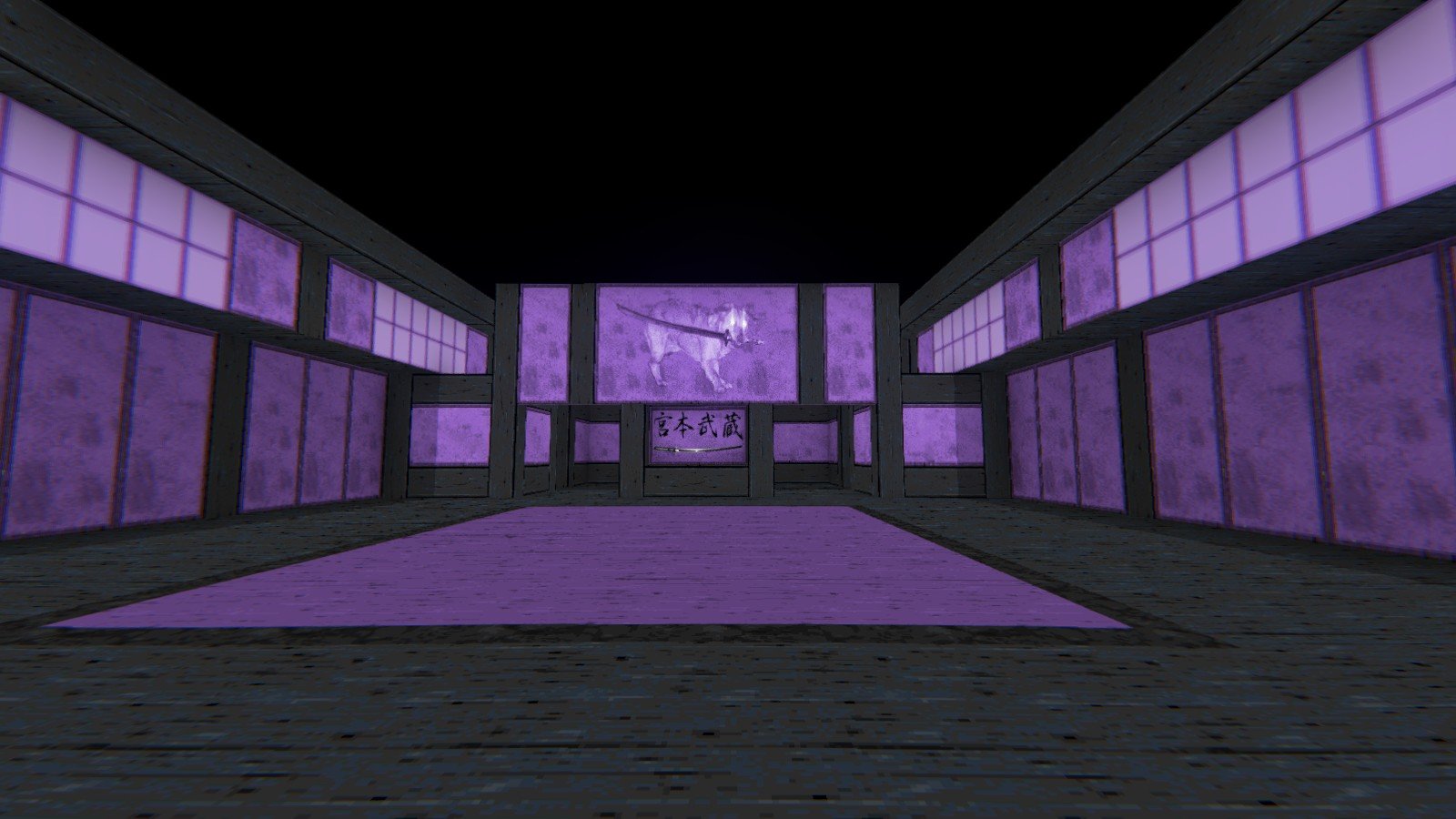 Pagodia will immediately remind you of the early levels of Stardate 20x7 or the second episode of Tarnsman's Projectile Hell, with the vibrant purple and the Japanese themes across the whole experience. However, as you make way through the lush jungles of violet trees and temples, you will come to realize that this is the sort of community project wherein every mapper shows their strengths and quirks with their own unique mapping style. Pagodia takes the player for a wondrous trip through jungles surrounded by pagodas (of course), caverns with mysterious purple liquids of unknown essence, a miniature version of cyberpunk Tokyo, and ending on a large imposing tech base surrounded by nukage that finishes off in a grand battle, and more of the aforementioned Mystery Juice.
Pagodia will immediately remind you of the early levels of Stardate 20x7 or the second episode of Tarnsman's Projectile Hell, with the vibrant purple and the Japanese themes across the whole experience. However, as you make way through the lush jungles of violet trees and temples, you will come to realize that this is the sort of community project wherein every mapper shows their strengths and quirks with their own unique mapping style. Pagodia takes the player for a wondrous trip through jungles surrounded by pagodas (of course), caverns with mysterious purple liquids of unknown essence, a miniature version of cyberpunk Tokyo, and ending on a large imposing tech base surrounded by nukage that finishes off in a grand battle, and more of the aforementioned Mystery Juice.
The landscapes of Pagodia are unique and contain certain elements and phenomena one doesn't see in your average Doom mapset – from neon-signs in Japanese, to restaurants that may or may not contain Revenant guests who either want to dine with you or punch you in the chin, and odes to a certain samurai dog.
The bestiary of enemies has been updated to match the fast paced gameplay, introducing everyone's favorite Green Belly Cyberdemon. Coincidentally, the Cacodemons of Pagodia must have drank some of the Mystery Juice – they're twice as fast and more aggressive. Or maybe they're just built different. The levels all range in size and difficulty to cater to all audiences, from small speedmap-like maps to grander nonlinear adventures, with the occasional pseudo-slaughter fight every so often.
I truly believe that Egg Boy and the crew have had as much fun creating Pagodia as I have enjoyed playing it. If you want a fresh breath of air from the reds and browns, Pagodia is just the kind of oxygen you need.
-
 Malevolence Episode 1 - @Cheesewheel
Malevolence Episode 1 - @Cheesewheel
Doom 2, Boom-compatible, 9 maps
Prepare yourself to face the odds, to stare the death they call Malevolence straight in its blood red eye, to carve a path of bloody destruction right to the heart of evil itself. That’s right, dear reader, Cheesewheel is back; bigger, badder and better than ever before!
Malevolence E1 is the latest and most bombastic entry in the author's on-going series of epic releases, beginning with CPD in 2020 and arguably achieving mature form in last year’s Uprising. Shared among all these works is a common vision: an elegant synthesis of low-level environmental storytelling, a potent sense of large-scale narrative, and loose, high-intensity dynamic action, all packaged in a clean, visually minimalist facade.
Manichaean struggle made human and engaging through the asymmetry of the underdog narrative is an enduring staple of fiction of all mediums, and has long been implicit in the domain of Doom mapping. Cheesewheel’s innovation is simple: say the quiet part aloud, make the apocalyptic clash between good and evil explicit, reinforce it through environmental framing and allow it to passively enhance the mechanical process of play. Hardly a novel approach in the scheme of things, but confidently executed at a scale rarely seen in Doom.
This element of narrative extends beyond mere set-dressing, instead coming to subtly define the progression of each work as a whole, informing and underlying the environmental continuity between individual maps. The end result is a series of bonafide campaigns of cinematic proportions, and a sense of grand adventure rarely found outside isolated megamaps.
All this would be moot if the action itself failed to deliver, but such an eventuality couldn’t be further from the truth. Cheesewheel’s unique style of combat is engaging as all hell, reminiscent of cannonball’s Return to Hadron trilogy in its dynamism and intensity, buoyed by the inclusion of D2’s extraordinarily synergistic bestiary and an authorial flair for the cinematic.
Malevolence takes this already potent cocktail and supercharges it with the inclusion of a dastardly array of cyberized villains, giving the dark side a much-needed shot in the arm a la Valiant, while simultaneously enhancing the player’s arsenal with a number of upgraded borg-busters. The resulting action is downright euphoric: endless battle, roiling and protracted, its pitch and intensity ebbing and flowing but never letting up until either you or Malevolence stand alone, a perfect mechanical analogue for the overarching narrative.
All this comes together into an odyssey of carnage, spanning an array of spacious techbases interwoven with large-scale naturalist environs and cavernous subterranean spaces, contrasting the harsh white, red and grey of man’s AI-subsumed abodes with the subtle browns and blues of the natural world. Interconnectivity is the order of day here, offering player and monster both a wealth of routes and sightlines across many height-levels, with geometry purpose-built to shape the action while allowing a range of possible outcomes, lending the set a great degree of replayability.
Truly, Malevolence E1 is a must-play for all those with an inclination for frenetic action and a desire for epicosity. So, don the guise of the hero, dear reader, and get to it!
-
 Anomaly Report - @valkiriforce
Anomaly Report - @valkiriforce
Doom 2, vanilla-compatible, 33 maps
valkiriforce is a creator whose body of work is in large part defined by a pervasive sense of warm nostalgia for the classic works that defined Doom’s first half-decade. This is not a blind love, however: far from an exercise in mere backwards-looking imitation, valkiriforce’s mapography demonstrates an astute vision, a willingness to separate the trappings of the era from its essence, to allow the rustic charm and sublime interface of abstraction and naive pseudo-realism so prevalent in ‘90s wads to shine through, unhindered by the practical realities that held the greats of yore back.
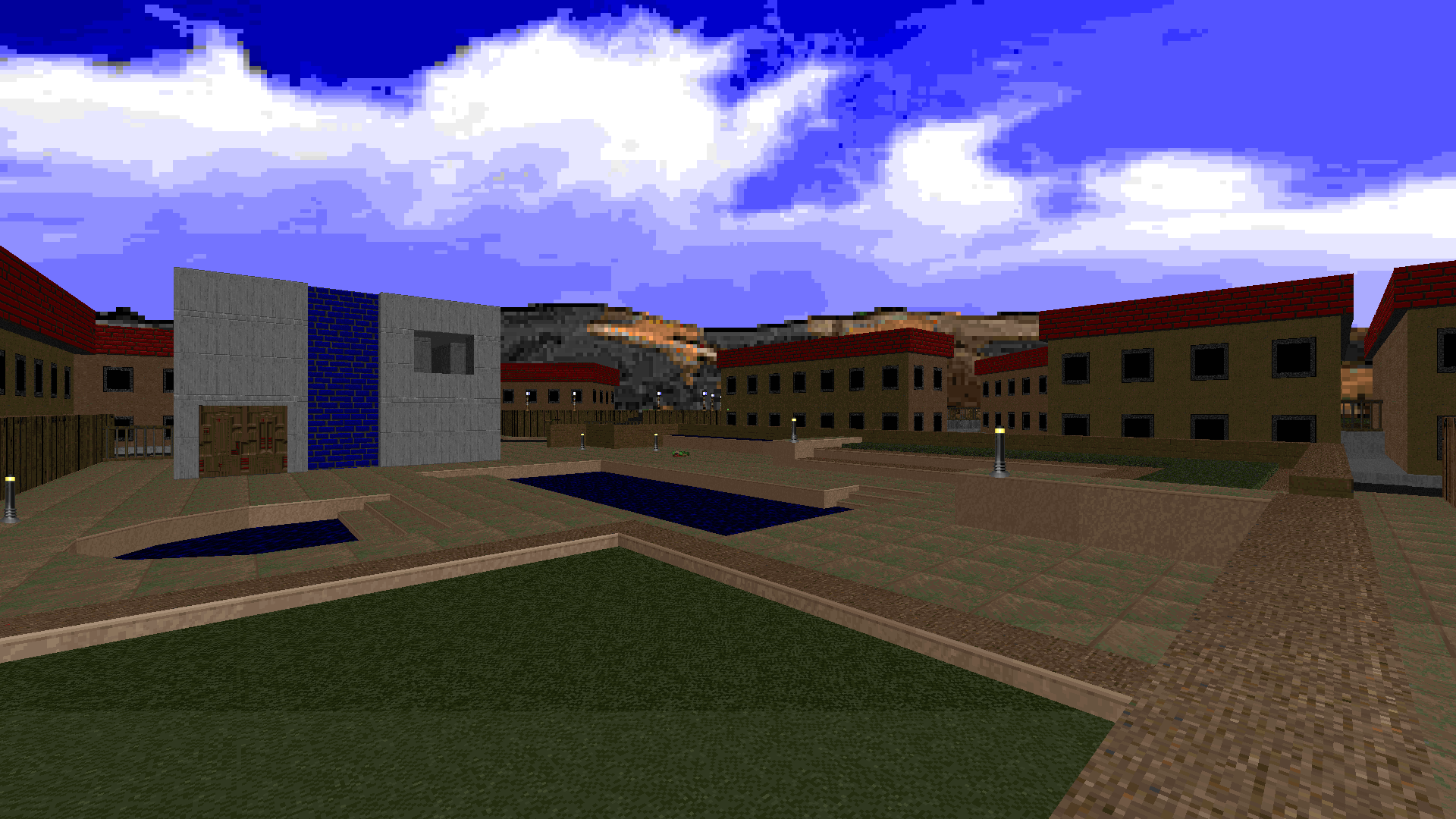 Anomaly Report is the latest and perhaps most refined incarnation of this vision, a curated distillation of this bygone age, a retro-revisionist piece that captures much of the eccentricity and innocence of the era while excising its more alienating qualities. The end result is a timeless Doom experience in the neoclassic vein: the result of a three way interaction between ‘90s nostalgia, the tenets and tendencies of the ‘TWiD movement and valkiriforce’s distinct personal style.
Anomaly Report is the latest and perhaps most refined incarnation of this vision, a curated distillation of this bygone age, a retro-revisionist piece that captures much of the eccentricity and innocence of the era while excising its more alienating qualities. The end result is a timeless Doom experience in the neoclassic vein: the result of a three way interaction between ‘90s nostalgia, the tenets and tendencies of the ‘TWiD movement and valkiriforce’s distinct personal style.
In terms of setting, staples of the ‘90s abound: oldschool techbases, minimalist representational settlements of various descriptions, abstract Memento Mori-esque outings and many more, all rendered in a clean retro-revisionist style featuring simple, shapely geometry clad in a range of stock and classic textures applied in a pleasing minimalist fashion. valkiriforce is an old hand, a master of the craft, and it shows in every element of the set’s construction: from progression to combat to presentation, Anomaly Report is an airtight production.
Underscoring this gold-tinted descent into an idyllic past is an era-appropriate soundtrack, consisting primarily of vintage midis by ‘90s legends Mark Klem, David Shaw, Jeremy Doyle and Tom Mustaine, a selection that links the set to its roots while simultaneously distinguishing its soundscape from contemporary releases, with the added benefit of exposing younger players (like myself) to some of Waddom’s finest composers.
Anomaly Report; a love-letter to the past with an eye for the future, and a real treat for all those with an inclination for the classic.
-
 Don't Turn Your Back on the City - @Trashbang
Don't Turn Your Back on the City - @Trashbang
Doom 2, Boom-compatible, 1 map
In the dank alleys of the city, history folds in on itself, squeezes you in, some kind of mystery around every corner and through every cracked-open door and bloody, corpse-sluicing vent. It's a rotted, fetid pace all the more creepy for how it still seems alive and thrumming with the activity of humans no longer present, showing that the takeover, the mountains of flesh that cake the vestibules and underpasses, must have snuffed everyone out quickly. Around every corner are narrative vignettes of violence, alluding to some fresh horror. But fortunately, the cacodemons and pain elementals have left the snazzy-ass Doomcute chandelier in the hotel alone for you to gawk at.
Trashbang's debut (!) is now part of an intermittent tradition of high-fidelity, painstakingly crafted levels popping out of nowhere: think Breach, Brigandine. Where Viggles' pair of maps, and some others in the lineage like Saturnine Chapel, embraced the Doom engine as conduit to exploring a very sophisticated material reality, Trashbang's work is just as likely to reject the ordinary concept of lines and sectors, to design as if by concocting custom "megatextures" out of a medley of materials, which are used like paint to depict a derelict street or opulent wall. It's as if the assets are just clay used to sculpt a personal vision, and the intended uses of materials, and the common abstractions of the engine, are always an easily abandoned suggestion.
This type of postcard-sized masterpiece is defined by the layeredness -- and optionality -- of its experience. A brisk playthrough might clock in at around a quarter-hour long, yet Trashbang's apocalyptic city is loaded with as much design effort as a multi-hour Sunderian odyssey. That might seem ill-advised -- won't so many people in this age of FOMO play through once, quickly, missing a lot, and be done with it? But the underlying gambit is that if it clicks for you, you're going to spend many multiples of fifteen minutes exploring it, interpreting everything it might allow you to interpret, thinking about how it's constructed, taking cues from it for your own design, imagining what came before and what lies beyond -- or just living with it inside you afterwards. There's just so much to pick apart there: it's the sort of map where you can trace claw marks in the chintzy hotel carpet to the imp possibly responsible and the fallen marine who met their (embarrassing if true) demise; where gratings leave simulated shadows, and pools of blood trace the contours of pebbles, subtly enough to be a gift to the attentive rather than something that demands acknowledgement.
For an experience this centered around design and atmosphere, Don't Turn Your Back… is consistently committed -- uncommonly so among pwads -- to meshing the gameplay beats with the intricacies of visual presentation. Rather than appearing as afterthoughts dumped within hyper-intricate structures too cumbersome to be changed, hell's infantry pours out of hotel rooms as if by their own agency; cacos drift out of towers, colonies of imps emerge out of nests of flesh. Even loiterers feel imbued with purpose (even if revenants make awful doormen -- pain elementals' shorter arms are better for carrying luggage). So fundamentally, the experience also excels as a dynamic narrative, much like a play.
Don't Turn Your Back On The City is just super comfortable. Despite the emphasis on physical reality, it feels like being in the middle of someone's imagination, alive in the world and all the dazzling contortions used to bring it to life. It's the dizzyingly, stubbornly intricate craft of a postcard gem like Brigandine, meeting the sort of ingenuity and personality you might find in JPCP, full of story and all delivered with the experimental kitchen-sink verve that characterizes so many first Doom maps. For that, I love it.
- @rd.
-
 2022: A Doom Odyssey - Paul "@pcorf" Corfiatis et al.
2022: A Doom Odyssey - Paul "@pcorf" Corfiatis et al.
Ultimate Doom, Boom-compatible, 50 maps
Paul Corfiatis, a figure well-known amongst aficionados of the classic, has - in collaboration with his long-time co-creators Kristian Nebula and Chris Hansen - rendered onto us a blast from the past, a grand reimagining of one of his most iconic works. After twenty years, it is time for another Doom Odyssey.
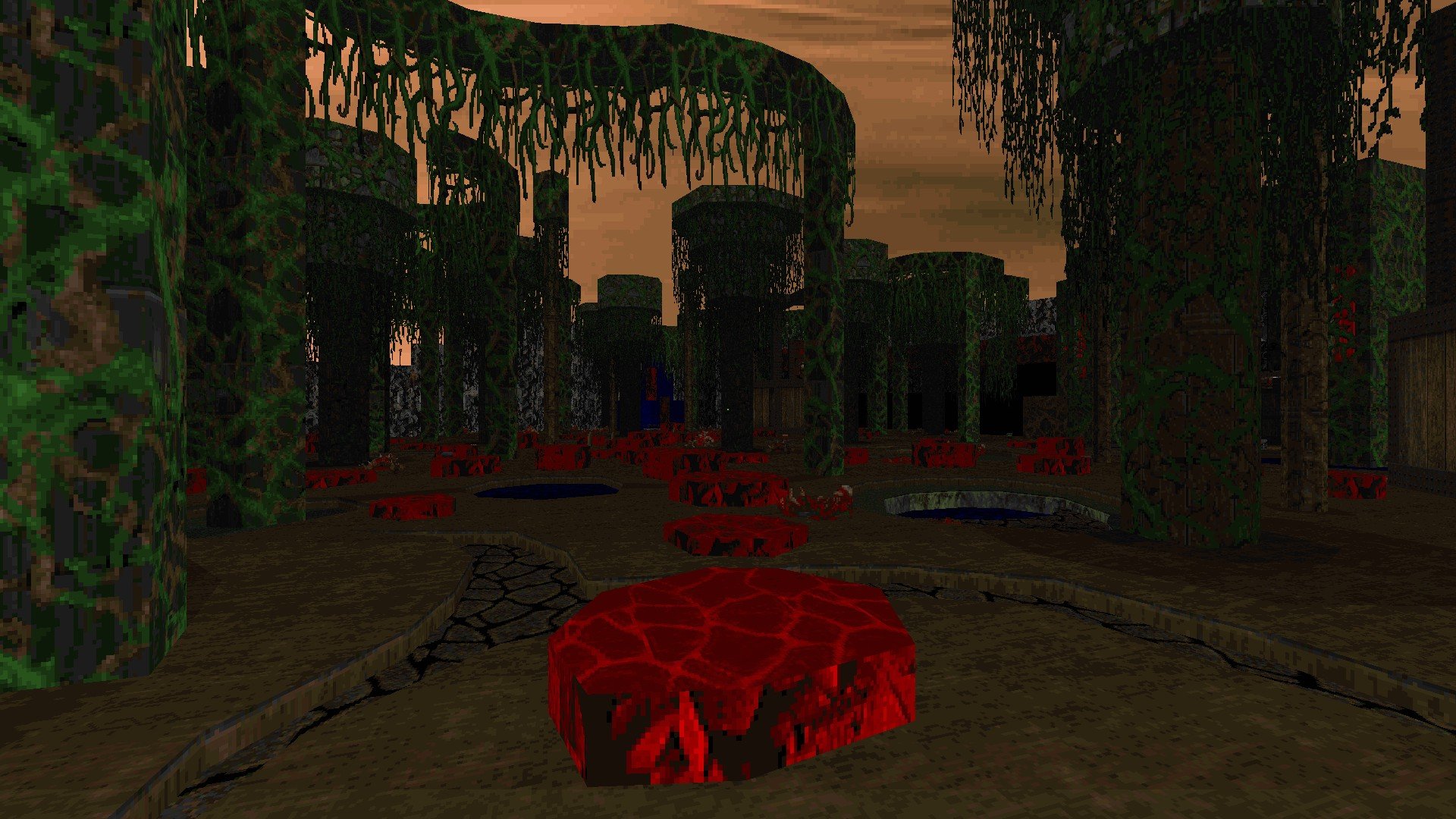 2022: ADO is an old soul clad in a retro-revisionist skin; a skeleton of timeless progression schema, classic themes and casual incidental combat hidden beneath a coat of clean modern texturing, refined lighting and shapely geometry. The experience of playing the set is at once timeless and modern, a curated descent into a familiar world; a return ticket to hell, if you will, first class with full room service and a complementary hissy plush.
2022: ADO is an old soul clad in a retro-revisionist skin; a skeleton of timeless progression schema, classic themes and casual incidental combat hidden beneath a coat of clean modern texturing, refined lighting and shapely geometry. The experience of playing the set is at once timeless and modern, a curated descent into a familiar world; a return ticket to hell, if you will, first class with full room service and a complementary hissy plush.
Of the four mainline episodes, Kristian Aro’s take on Inferno stands the tallest, straying somewhat from the baseline expectations set by the source material and the genre as a whole and delving into more adventuresome territory, featuring an array of large, complex outings that expand the hell aesthetic to rarely-seen proportions.
It is, however, the set’s final episode that shatters the reverie of remembrance; with no old ground to tread, the most logical option was to riff on Ultimate Doom’s unofficial and unexpected epilogue, and pcorf sure knows how to shred a guitar. Incendio Crucio is an authorial tour de force, an original and transformative take on John Romero’s Sigil that ratchets up the challenge factor significantly and dramatically breaks from the formulae of prior episodes, escalating in intensity before culminating in one of the most visually striking and creative outings in pcorf’s vast mapography.
2022: ADO ends on a high note, having provided throughout its significant runtime a dose of classic, nostalgic fun, tempered by modern standards of craft, as well as a number of more ambitious experiences. Underscored by an entirely new bespoke soundtrack – including a few remasters that are sure to please longtime fans – this long-awaited recursive odyssey is a genuine treat for all those with a soft-spot for OG Doom, and a milestone marking just how far this community has come.




